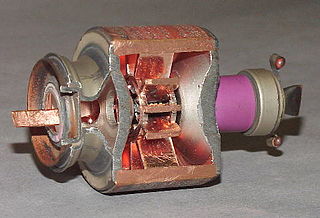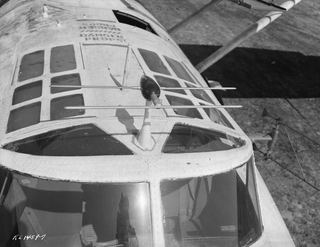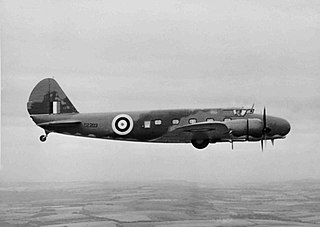Related Research Articles

The cavity magnetron is a high-power vacuum tube used in early radar systems and subsequently in microwave ovens and in linear particle accelerators. A cavity magnetron generates microwaves using the interaction of a stream of electrons with a magnetic field, while moving past a series of cavity resonators, which are small, open cavities in a metal block. Electrons pass by the cavities and cause microwaves to oscillate within, similar to the functioning of a whistle producing a tone when excited by an air stream blown past its opening. The resonant frequency of the arrangement is determined by the cavities' physical dimensions. Unlike other vacuum tubes, such as a klystron or a traveling-wave tube (TWT), the magnetron cannot function as an amplifier for increasing the intensity of an applied microwave signal; the magnetron serves solely as an electronic oscillator generating a microwave signal from direct current electricity supplied to the vacuum tube.

HMCS Sackville is a Flower-class corvette that served in the Royal Canadian Navy and later served as a civilian research vessel. She is now a museum ship located in Halifax, Nova Scotia, and the last surviving Flower-class corvette.
Defence Research and Development Canada is the science and technology organization of the Department of National Defence (DND), whose purpose is to provide the Canadian Armed Forces (CAF), other government departments, and public safety and national security communities with knowledge and technology.

The history of radar started with experiments by Heinrich Hertz in the late 19th century that showed that radio waves were reflected by metallic objects. This possibility was suggested in James Clerk Maxwell's seminal work on electromagnetism. However, it was not until the early 20th century that systems able to use these principles were becoming widely available, and it was German inventor Christian Hülsmeyer who first used them to build a simple ship detection device intended to help avoid collisions in fog. True radar, such as the British Chain Home early warning system, which provided directional information about objects over short ranges, was developed over the next two decades.
Edward George "Taffy" Bowen, CBE, FRS, was a Welsh physicist who made a major contribution to the development of radar. He was also an early radio astronomer, playing a key role in the establishment of radioastronomy in Australia and the United States.

Anti-submarine warfare is a branch of underwater warfare that uses surface warships, aircraft, submarines, or other platforms, to find, track, and deter, damage, or destroy enemy submarines. Such operations are typically carried out to protect friendly shipping and coastal facilities from submarine attacks and to overcome blockades.
Arthur Edwin Covington was a Canadian physicist who made the first radio astronomy measurements in Canada. Through these he made the valuable discovery that sunspots generate large amounts of microwaves at the 10.7 cm wavelength, offering a simple all-weather method to measure and predict sunspot activity, and their associated effects on communications. The sunspot detection program has run continuously to this day.
John Tasker Henderson was a Canadian Physicist whose career was with the National Research Council (NRC). Educated at McGill and London, Henderson joined the NRC in 1933 where he worked on the effects of the ionosphere on radio signals and the Direction Finder invented by A.G.L. McNaughton and W.A. Steel.
Radar in World War II greatly influenced many important aspects of the conflict. This revolutionary new technology of radio-based detection and tracking was used by both the Allies and Axis powers in World War II, which had evolved independently in a number of nations during the mid 1930s. At the outbreak of war in September 1939, both the United Kingdom and Germany had functioning radar systems. In the UK, it was called RDF, Range and Direction Finding, while in Germany the name Funkmeß (radio-measuring) was used, with apparatuses called Funkmessgerät . By the time of the Battle of Britain in mid-1940, the Royal Air Force (RAF) had fully integrated RDF as part of the national air defence.

HMCS Chambly was a Flower-class corvette serving in the Royal Canadian Navy. She was ordered from Canadian Vickers Ltd. in Montreal, laid down on 20 February 1940, launched on 29 July, and commissioned on 18 December 1940, named after the city of Chambly, Quebec. Chambly escorted trade convoys between Halifax Harbour and the Western Approaches through the battle of the Atlantic and, together with HMCS Moose Jaw, achieved the RCN's first U-boat kill of the war.

Diffused lighting camouflage was a form of active camouflage using counter-illumination to enable a ship to match its background, the night sky, that was tested by the Royal Canadian Navy on corvettes during World War II. The principle was discovered by a Canadian professor, Edmund Godfrey Burr, in 1940. It attracted interest because it could help to hide ships from submarines in the Battle of the Atlantic, and the research project began early in 1941. The Royal Navy and the US Navy carried out further equipment development and trials between 1941 and 1943.
C. Lorenz AG (1880–1958) was a German electrical and electronics firm primarily located in Berlin. It innovated, developed, and marketed products for electric lighting, telegraphy, telephony, radar, and radio. It was acquired by ITT in 1930 and became part of the newly founded company Standard Elektrik Lorenz (SEL) Stuttgart in 1958, when it merged with Standard Elektrizitätsgesellschaft and several other smaller companies owned by ITT. In 1987, SEL merged with the French companies Compagnie Générale d'Electricité and Alcatel to form the new Alcatel SEL.

Research Enterprises Limited was a short-lived Toronto-based Crown Corporation that built electronics and optical instruments during World War II. They existed only six years from late 1940 until 1946, and were active only from late 1941, but during that period they became Leaside's largest employer, producing C$220 million worth of radar systems and optical instruments. After the war, the government rapidly closed the various wartime companies it had started. After REL was closed, their factories formed the basis of a Corning Glass plant, Philips Electronics, and a variety of other firms. Today only a few of the original buildings still stand, used primarily for light industrial and small commercial enterprises.

Radar, Gun Laying, Mark III, or GL Mk. III for short, was a radar system used by the British Army to directly guide, or lay, anti-aircraft artillery (AA). The GL Mk. III was not a single radar, but a family of related designs that saw constant improvement during and after World War II. These were renamed shortly after their introduction in late 1942, becoming the Radar, AA, No. 3, and often paired with an early warning radar, the AA No. 4, which was also produced in several models.

Radar, Air to Surface Vessel, Mark II, or ASV Mk. II for short, was an airborne sea-surface search radar developed by the UK's Air Ministry immediately prior to the start of World War II. It was the first aircraft-mounted radar of any sort to be used operationally. It was widely used by aircraft of the RAF Coastal Command, Fleet Air Arm and similar groups in the United States and Canada. A version was also developed for small ships, the Royal Navy's Type 286.

Radar, Air-to-Surface Vessel, Mark III, or ASV Mk. III for short, was a surface search radar system used by RAF Coastal Command during World War II. It was a slightly modified version of the H2S radar used by RAF Bomber Command, with minor changes to the antenna to make it more useful for the anti-submarine role. It was Coastal Command's primary radar from the spring of 1943 until the end of the war. Several improved versions were introduced, notably the ASV Mark VI, which replaced most Mk. IIIs from 1944 and ASV Mark VII radar, which saw only limited use until the post-war era.
The AN/SQS-504 Diver was an early naval medium-frequency active variable depth sonar (VDS) developed in Canada.

DZ203, a Boeing 247 airliner, was among the most important single aircraft used in the development of various airborne radar and blind-landing systems. It is particularly notable as the first aircraft to perform a completely automatic approach and landing, in January 1945.

SW1C, short for Surface Warning, Model 1, Canadian, was an early radar system developed by the National Research Council of Canada (NRC) for the Royal Canadian Navy (RCN).
References
Citations
Bibliography
- Middleton, William (16 March 1981). Radar Development in Canada: The Radio Branch of the National Research Council. Wilfrid Laurier University Press. ISBN 9780889201064.
- Merklinger, Harold (2009). "Maritime Research and Development in the Second World War". In Gimblett, Richard (ed.). The Naval Service of Canada, 1910–2010: The Centennial Story. Dundurn. ISBN 9781459713284.
- Shore Based Search Radar – "Night Watchman" (NW). ERA 141- The War History of the National Research Council Radio Branch (Technical report). Radio Branch, National Research Council. 1948.